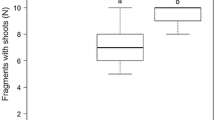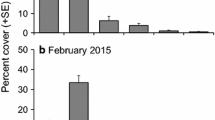Abstract
Historically described as cosmopolitan but rare, the benthic diatom Didymosphenia geminata is now considered a nuisance, bloom-forming and invasive species. In New Zealand, D. geminata was first recorded in 2004 in the lower Waiau River. By winter 2008 it had been identified in 26 major catchments. To investigate invasion success of D. geminata in relation to succession and biomass accumulation of native periphyton communities, we conducted a two-factorial field experiment. Seven successional stages of a native periphyton community (substrate exposure time: 0–49 days) were exposed to two D. geminata propagule concentrations (low and high) for 25 days. D. geminata propagule concentration and successional stage of the native periphyton community significantly affected the invasion success of D. geminata. While D. geminata invasion was low on all substrates that had been exposed to the low D. geminata propagule concentration, there was a unimodal relationship between invasion success and substrate exposure time at the high propagule concentration. D. geminata abundance was low on uncolonised substrates, increased when the native communities were 1- or 2-week-old, and low when the age of the native communities was 4 or more weeks. These results imply that D. geminata is a late successional species that needs some existing structure to anchor to a substrate. Although late successional stages of the native periphyton community displayed partial resistance to D. geminata invasion, trying to keep D. geminata abundances as low as possible appears to be the only way to manage this species at this time.




Similar content being viewed by others
Abbreviations
- DRP:
-
Dissolved reactive phosphorus
- DIN:
-
Dissolved inorganic nitrogen
- DRSi:
-
Dissolved reactive silicate
- AFDW:
-
Ash-free dry weight
- CHL:
-
Chlorophyll
- SET:
-
Substrate exposure time
References
Antoine SE, Benson-Evans K (1986) Spatial and temporal distribution of some interesting diatom species in the River Wye System, Wales. UK Limnologica 17:79–86
Baars JWM (1983) Autecological invstigations on freshwater diatoms. I: generation times of some species. Arch Hydrobiol Suppl Monogr 67:11–18
Beltrami ME, Blanco S, Ciutti F, Cappelletti C, Monauni C, Pozzi S, Rimet F, Ector L (2008) Distribution and ecology of Didymosphenia geminata (Lyngbye) M. Schmidt (Bacillariophyta) in Trentino watercourses (Northern Italy). Crypt Alg 29:141–160
Bhatt JP, Bhaskar A, Pandit MK (2008) Biology, distribution and ecology of Didymosphenia geminata (Lyngbye) Schmidt an abundant diatom from the Indian Himalayan rivers. Aquat Ecol 42:347–353
Biggs BJF (1996) Patterns in benthic algae of streams. In: Stevenson RJ, Lowe RL (eds) Algal ecology. Academic Press, New York, pp 31–56
Biggs BJF (2000a) New Zealand periphyton guideline: detecting, monitoring and managing enrichment of streams. The Ministry for the Environment, Wellington
Biggs BJF (2000b) Eutrophication of streams and rivers: dissolved nutrient-chlorophyll relationships for benthic algae. J N Am Benthol Soc 19:17–31
Biggs BJF, Kilroy C (2000) Stream periphyton monitoring manual. NIWA, Christchurch
Boalch GT, Harbour DS (1977) Unusual diatom off the coast of south-west England and its effect on fishing. Nature 269:687–688
Bothwell ML (1989) Phosphorus-limited growth dynamics of lotic periphytic diatom communities: areal biomass and cellular growth rate responses. Can J Fish Aquat Sci 46:1293–1301
Campbell ML (2008) Organism impact assessment: risk analysis for post-incursion management. ICES J Mar Sci 65:795–804
Cardinale BJ, Hillebrand H, Charles DF (2006) Geographic patterns of diversity in streams are predicted by a multivariate model of disturbance and productivity. J Ecol 94:609–618
Dodds WK, Jones JR, Welch EB (1998) Suggested classification of stream trophic state: distributions of temperate stream types by chlorophyll, total nitrogen, and phosphorus. Water Res 32:455–1462
Edwards M, John AWG, Johns DG, Reid PC (2001) Case history and persistence of the non-indigenous diatom Coscinodiscus wailesii in the north-east Atlantic. J Mar Biol Assoc UK 81:207–211
Ellwood NTW, Whitton BA (2007) Importance of organic phosphate hydrolyzed in stalks of the lotic diatom Didymosphenia geminata and the possible impact of climate change. Hydrobiologia 592:121–133
Hallegraeff GM, Bolch CJ (1992) Transport of diatom and dinoflagellate resting spores in ships’ ballast waters: implications for phytoplankton biogeography and aquaculture. J Plankton Res 14:1067–1084
Hallegraeff GM, Steffensen DA, Wetherbee R (1988) Three estuarine Australian dinoflagellates that can produce paralytic shellfish toxins. J Plankton Res 10:533–541
Hamilton PB, Duthie HC (1987) Relationship between algal drift, discharge and stream order in a boreal forest watershed. Arch Hydrobiol 110:275–289
Hillebrand H, Dürselen CD, Kirschtel D, Pollingher U, Zohary T (1999) Biovolume calculation for pelagic and benthic microalgae. J Phycol 35:403–424
Hoagland KD, Roemer SC, Rosowski JR (1982) Colonization and community structure of two periphyton assemblages with emphasis on the diatoms (Bacillariophyceae). Am J Bot 69:188–213
Hustedt F (1930) Bacillariophyta (Diatomeae). Gustav Fischer, Stuttgart
Irwin A, Hallegraeff GM, McMinn A, Harrison J, Heijnis H (2003) Cyst and radionuclide evidence demonstrate historic Gymnodinium catenatum dinoflagellate populations in Manukau and Hokianga Harbours, New Zealand. Harmful Algae 2:61–74
Kawecka B, Sanecki J (2003) Didymosphenia geminata in running waters of southern Poland—symptoms of change in water quality? Hydrobiologia 495:193–201
Kilroy C (2004) A new alien diatom, Didymosphenia geminata (Lyngbye) Schmidt: its biology, distribution, effects and potential risks for New Zealand fresh waters. NIWA, Christchurch, p 34
Kilroy C, Biggs B, Blair N, Lambert P, Jarvie B, Dey K, Robinson K, Smale D (2006) Ecological studies on Didymosphenia geminata. NIWA, Christchurch, p 66
Kilroy C, Snelder TH, Floerl O, Vieglais CC, Dey KL (2008) A rapid technique for assessing the suitability of areas for invasive species applied to New Zealand’s rivers. Divers Distrib 14:262–272
Kilroy C, Larned ST, Biggs BJF (2009) The non-indigenous diatom Didymosphenia geminata alters benthic communities in New Zealand rivers. Freshw Biol. doi:10.1111/j.1365-2427.2009.02247.x
Kirkwood AE, Shea T, Jackson L, McCauley E (2007) Didymosphenia geminata in two Alberta headwater rivers: an emerging invasive species that challenges conventional views on algal bloom development. Can J Fish Aquat Sci 64:1703–1709
Koksvik JI, Reinertsen H (2008) Changes in macroalgae and bottom fauna in the winter period in the regulated Alta River in northern Norway. River Res Appl 24:720–731
Korte VL, Blinn DW (1983) Diatom colonization on artificial substrata in pool and riffle zones studied by light and scanning electron microscopy. J Phycol 19:332–341
Krammer K, Lange-Bertalot H (1997) Bacillariophyceae 1. Naviculaceae. Fischer, Jena
Laing I, Gollasch S (2002) Coscinodiscus wailesii: a nuisance diatom in European waters. In: Leppäkoski E, Stephan Gollasch S, Olenin S (eds) Invasive aquatic species of Europe: distribution, impacts and management. Springer, Berlin, pp 53–55
Liao N (2001) Lachat instruments methods manual. Lachat Instruments, Loveland
Løvstat Ø (1984) Competitve ability of laboratory batch phytoplantkon populations at limiting nutrient levels. Oikos 42:176–184
MacArthur RH (1972) Geographical ecology: patterns in the distribution of species. Harper & Row, New York
McCormick PV, Stevenson RJ (1991) Mechanisms of benthic algal succession in lotic environments. Ecology 72:1835–1848
Mee LD, Espinosa M, Diaz G (1986) Paralytic shellfish poisoning with a Gymnodinium catenatum red tide on the Pacific coast of Mexico. Mar Environ Res 19:77–92
Murdock JN, Dodds WK (2007) Linking benthic algal biomass to stream substratum topography. J Phycol 43:449–460
Nascimento SM, Lilly EL, Larsen J, Morris S (2005) Toxin profile, pigment composition, and large subunit rDNA phylogenetic analysis of an Alexandrium minimum (Dinophyceae) strain isolated from the Fleet Lagoon, United Kingdom. J Phycol 41:343–353
Nunes PALD, Markandya A (2008) Economic value of damage caused by marine bio-invasions: lessons from two European case studies. ICES J Mar Sci 65:775–780
Patrick R, Reimer CW (1975) The diatoms of the United States, exclusive of Alaska and Hawaii. Academy of Natural Sciences of Philadelphia, Philadelphia
Peterson CG (1996) Mechanisms of lotic microalgal colonization following space-clearing disturbances acting at different spatial scales. Oikos 77:417–435
Peterson CG, Stevenson RJ (1989) Substratum conditioning and diatom colonization in different current regimes. J Phycol 25:790–793
Pickett STA, Collins SL, Armesto JJ (1987) Models, mechanisms and pathways of succession. Bot Rev 53:335–371
Poff NL, Voelz NJ, Ward JV (1990) Algal colonization under four experimentally-controlled current regimes in a high mountain stream. J N Am Benthol Soc 9:303–318
Redfield AC (1958) The biological control of chemical factors in the environment. Am Sci 46:207–221
Reynolds CS (1984) Phytoplankton periodicity: the interactions of form, function and environmental variability. Freshw Biol 14:111–142
Reynolds CS (1988) The concept of ecological succession applied to seasonal periodicity of freshwater phytoplankton. Verh Int Verein Limnol 23:683–691
Sekar R, Venugopalan VP, Nandakumar K, Nair KVK, Rao VNR (2004) Early stages of biofilm succession in a lentic freshwater environment. Hydrobiologia 512:97–108
Smayda TJ (2007) Reflections on the ballast water dispersal—harmful algal bloom paradigm. Harmful Algae 6:601–622
Sommer U (1991) Phytoplankton: directional succession and forced cycles. Ecol Stud 85:132–146
Spaulding S, Elwell L (2007) Increase in nuisance blooms and geographic expansion of the freshwater diatom Didymosphenia geminata: recommendations for response. White paper. United States Environmental Protection Agency, Federation of Fly Fishers, Montana, p 33
Steinman AD, McIntire CD (1990) Recovery of Lotic Periphyton communities after disturbance. Environ Manage 14:580–604
Stevenson RJ (1983) Effects of current and conditions simulating autogenically changing microhabitats on benthic diatom immigration. Ecology 64:1514–1524
Stevenson RJ, Peterson CG (1989) Variation in benthic diatom (Bacillariophyceae) immigration with habitat characteristics and cell morphology. J Phycol 25:120–129
Stevenson RJ, Peterson CG (1991) Emigration and immigration can be important determinants of benthic diatom assemblages in streams. Freshw Biol 26:279–294
Tilman D (1977) Resource competition between planktonic algae: an experimental and theoretical approach. Ecology 58:338–348
Utermöhl H (1958) Zur Vervollkommnung der quantitativen Phytoplankton Methodik. Mitt Int Ver Theor Angew Limnol 9:1–39
Whitton BA, Crisp DT (1984) Tees. In: Whitton BA (ed) Ecology of European rivers. Blackwell, Oxford, pp 145–178
Acknowledgments
Neil Blair, Derek Kater, Kevin Trainor, Kirsten Haigh helped with the fieldwork, Haojin Tan did the chlorophyll analysis, James and Marie Galland of Elmwood Station provided access to the sites at Elm Tree Creek, Bill Jarvie’s valuable information on Southland streams was a great help when choosing the experimental sites, and the comments of Deanne Drake and Brian Whitton greatly improved the manuscript. Thank you all very much!
Author information
Authors and Affiliations
Corresponding author
Rights and permissions
About this article
Cite this article
Flöder, S., Kilroy, C. Didymosphenia geminata (Protista, Bacillariophyceae) invasion, resistance of native periphyton communities, and implications for dispersal and management. Biodivers Conserv 18, 3809–3824 (2009). https://doi.org/10.1007/s10531-009-9681-8
Received:
Accepted:
Published:
Issue Date:
DOI: https://doi.org/10.1007/s10531-009-9681-8




